The Bluetti AC200L is an expandable power station with a large 2048Wh capacity with expansion and a very high output of 2400W (3600W with the Power Lifting boost mode). But there. it’s incredibly heavy, uses a lot of proprietary sockets and cables, and the socket design is peculiar for UK users. And yes, there’s an app for it, too.
Pros
- +
Large 2048Wh capacity with expansion
- +
Very high output of 2400W
- +
Plenty of ports, plugs, sockets
- +
Quiet operation
- +
UPS mode and sine wave output
- +
Possibility to charge from several different sources
- +
Simultaneous AC, DC and USB output
Cons
- –
HEAVY!
- –
Propriety AC and DC input cables
- –
Odd orientation of 230v plug sockets with aforementioned fouling of rubber gaskets
- –
Another app
- –
Not compatible with own brand microinverter
Why you can trust TechRadar We spend hours testing every product or service we review, so you can be sure you’re buying the best. Find out more about how we test.
The Bluetti AC200L promises an expandable power station solution. Boasting a 2400W AC output (or 3600W in Power Lifting Mode), does it provide the ideal back-up power supply? We put the Bluetti AC200L power station to the test.
Bluetti AC200L: Packaging
The Bluetti AC200L came in a large plain looking cardboard box with wrap-around plastic straps and additional cardboard edge protectors.
You couldn’t exactly call this a portable power station. In total the Bluetti AC200L including packaging weighed in a hefty 33kg, so would need two people to move it comfortably and safely.
Inside the outer box was another, equally plain looking cardboard box only with the product name attached to it. Note that you must keep this second box in order to honour the warranty, also getting this second box out of the first was a task in and of itself.
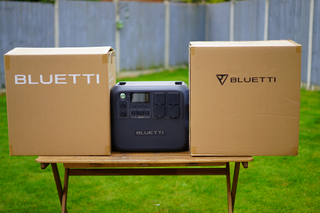
Opening the main box revealed the documentation and small sack of accessory wires.
The Bluetti AC200L itself was wrapped in a plastic sheath and sandwiched between two large polystyrene bumpers, top and bottom. Once out I was able to take stock of what was provided other than the Bluetti AC200L and documentation.
- AC power cord with UK plug to charge the Bluetti AC200L
- A 12v car cigarette plug to XT90 connector
- A MC4 connectors to XT90
- XT90 connector to DC plug;
- A small grounding screw
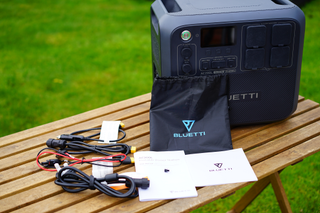
Bluetti AC200L: Fit & feel
The Bluetti AC200L came with a 55% rate which is normal for its LiFePO4 chemistry for storage and transport.
The Bluetti AC200L weighs in at around 28kgs, it is made of a dark grey plastic material with a pretty stripey like texture all around, it comes with large rubberised feet to allow it to feel planted on any relatively flat surface.
Part of its design (and it does need it) are two very large carry handles on either side to ease with transportation.
The front and left side are the main working parts of the battery that consumers would interact with various sockets and ports for charging and using.
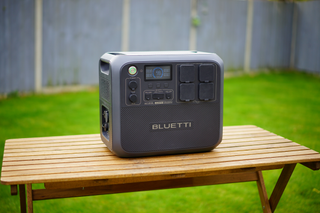
At the front of the unit are the following:
4 x UK sockets providing 230v with a total combined sustained output of 2400w
2 x USB-C both capable of outputting 100w each
2 x USB-A 18W max each
1 x 12v (max 10A) car charger port
1 x 48v DC (max 8A) normally used for RVs
Power on/off button and;
Lastly the large information LCD display screen
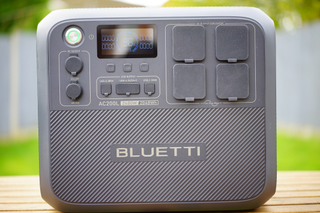
At the side are the following ports:
AC input (proprietary socket)
DC Input (proprietary socket)
And a Battery expansion port
Also on this side are the circuit breaker and a grounding pole
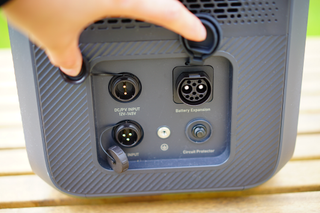
All sockets have captive rubber gaskets over them however the Bluetti AC200L itself does not have an IP rating.
Bluetti AC200L: In use
Having taken receipt of the Bluetti AC200L the first thing I wanted to do was charge it to 100% and here is where I spotted the first design flaw. The AC and DC charging ports are proprietary sockets, so don’t go losing those charging cables. Furthermore when trying to plug the AC cable in which has three pins corresponding to live, neutral and earth, the socket and plug is keyed to prevent crossing the lines but without a clear indication as to which way “UP” is supposed to be, I spent a good few seconds twisting the plug to get the key right before plugging the AC cord it.
There are numbers embossed on the AC, corresponding to each pin and socket, but they are very small and hard to see, especially in low light conditions. Scroll through the gallery below to see the AC example.
I also noted that the DC input has a proprietary socket, again keyed to prevent crossing the negative and positive without a clear indication as to where up is on the plug itself. The plug has a single piece of cable attached to it terminating in a XT90 female connector. From that you then plug in a male XT90 terminating with either the Solar Panel MC4 connector or 12V car charger plug.
I found Bluetti’s decision to use proprietary plugs and sockets for the AC and DC charging on the ACC200L an odd choice. If you were to lose either or both cables then you would have to source them directly from Bluetti. At my last look the AC power cable for the AC200L isn’t available on Bluetti’s UK website, but one for the AC300 retails at £29.99.
It would have made more sense to just have a common AC power socket like those found on common desktop computers such as the IEC C14 and for DC just to incorporate the XT90 plug in the body of the battery, other competitor batteries and battery brands do it.
I noted that at left on normal charging mode the unit drew down 1200kWh, it charged the unit within an hour with a quiet yet audible fan whirr. There are other modes of charging, Turbo for when you want the unit ready as soon as possible and Silent which keeps the internal fan off at the cost of a slower charging speed.
The Bluetti AC200L can be charged from multiple sources and even allows through charging where it can provide power to a device whilst itself is charging. Of course, it can be charged from the grid using the provided AC charging cable, it can be charged via DC using the provided cable and the plugging into the female XT90 connector the appropriate DC input, be it the DC car charger or Solar Panels from the MC4 connectors provided. Alternatively, it can also be charged from a car battery with a separately available cable with crocodile clips.
Once fully charged I was able to use it, the first task I performed with it was to use it for one of the most mundane household tasks, which also draws the most electrical energy, Ironing.
It was then I noted a major flaw. It is evident that the 230v socket section was designed with either US or EU style plugs in mind where the cord comes straight out unlike UK plugs where the cord comes out the bottom. This means that whilst the bottom two sockets and their rubber covers fit UK plugs without issue, the top sockets won’t. The rubber cover for the top sockets are positioned above the sockets, the sockets are turned 180 degrees so that the earth pin is now at the bottom and this means that where the cord would normally come out the bottom, it now goes upwards causing it to foul with the rubber cover. Whilst you could force it in this may place undue stress on the cord or the rubber cover.
Using a power Steam Generator iron, I completed a one and a half hours’ worth of ironing with the iron drawing up to 2200W at times. This brought the battery from 100% to 40%, the Bluetti AC200L was able to do this without breaking a sweat.
Charging the battery back up again, I was then able to use it to cook various food stuffs in our air fryer, again the Bluetti AC200L provided the energy needed to run such a high demand item. It ran our under-counter freezer no problem however I was unable to test the duration but in an emergency power outage it would be a good go-to product.
With regards to its combined 2400W output, according to the documentation it can actually (albeit briefly) output 3600W and a “power lifting” mode for use on high resistive loads such as kettles, this must be set manually using the buttons and is not to be on default.
I noted that one of its useful features would be to charge it up overnight on cheaper electricity, then use it about the house during the day (weight withstanding) to reduce the dependence on peak price electricity.
The large LCD display screen was very useful in monitoring live energy input/output from all sources, the screen displays percentage of battery remaining, roughly in time how much is left depending on the discharge as well as what the battery is dis/charging at and where.
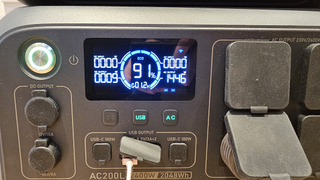
There is an app available for the battery allowing you to monitor DC in/out, AC in /out and various other features to configure. The AC200L has a Bluetooth connection for local use and even Wi-Fi for remote use. Some will like the app functionality; others won’t and frankly it’s just another app in the catalogue of apps on most phones.
Also of note is a battery expansion port which can be used to extend the capacity of the AC200L, there are separately available Bluetti B210, 230 and 300 expansion batteries available. Sadly, whilst the AC200L does have the expansion port which can have current flowing both ways for dis/charge, it cannot be used as part of an excess Solar store system for a residential home, despite Bluetti having a Solar micro inverter and battery charger (the A80 and D100S respectively), these are not compatible with the AC200L.
A shame really and possibly a missed opportunity, competitor products such as the EcoFlow PowerStream allows you use most of their battery line ups to do just this, though not yet available in the UK, rumours are it’s coming soon.
A noted and useful feature is that this battery can be used as a UPS providing power to equipment in the event of a grid power loss with near instant switchover and true sine wave output as some equip is sensitive to stepped wave inputs.
Should I buy the Bluetti AC200L
Buy it if…
You want the high output capacity
With a 2400W output capacity, boosted up the 3600W when you need it, it’s a useful unit for powering devices that draw a lot of power.
You want to run a lot of devices
Packed with ports and sockets, the AC200L is a good option for those who need to connect a lot of difference devices, even at the same time.
Don’t buy it…
You need a truly portable power station
The Bluetti AC200L is a very heavy unit, weighing in at 28kg, so it’s not the best choice when you need to easily transport it, especially if you’re doing it single-handedly.
You hate proprietary cables
One of the biggest issues with the AC200L is the use of proprietary AC and DC cables, so make sure you don’t lose them.

